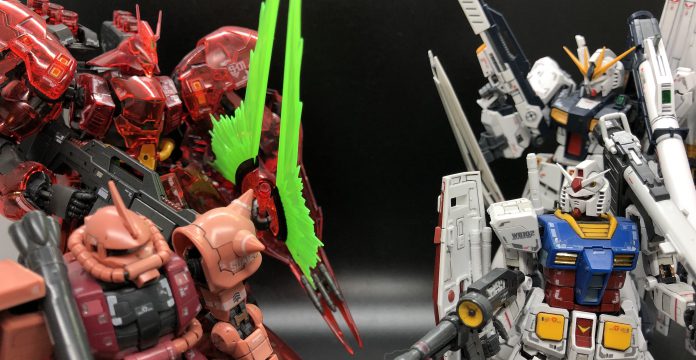In the latest installment of a new Bit here, we’re reviewing Bandai’s gunpla, a model kit of a robot from the Gundam universe. It’s a little outside our usual coverage, and there might be some light spoilers for the anime. This week: Bandai’s High Grade Zaku II, from Mobile Suit Gundam the Origin.
In the show
The first thing we need to talk about here is the model number. This is, technically, the MS-06C-6/R6 Zaku II Type C-6/R6. It’s going to take some explaining to understand all that. Functionally, it’s just a Zaku.
This particular Zaku is from Gundam: The Origin, which is a prequel (manga first, then animated as a series of 6 movies) to the original Mobile Suit Gundam, that spends most of its runtime backfilling the history of mobile suits in the run-up to the One Year War. In canon, the Zaku was the first combat-use mobile suit, and it had the same level of impact that HMS Dreadnought or cartridge-based firearms did: when it dropped, every other weapons system immediately became obsolete. It is, in the Universal Century timeline, the single biggest change to war-fighting in history, and changed the fate of the entire Earth sphere. In Mobile Suit Gundam and the other shows set in this era, however, it is utterly disposable, a bad guy grunt that gets clowned on to make everyone else look better. Classic fluff/crunch divide. If you want a better example of the Zaku doing Zaku shit, the Origin movies have it: a single guy in a robot, zipping around outer space with a semi-auto sniper rifle the size of a building, one-shotting battleships.
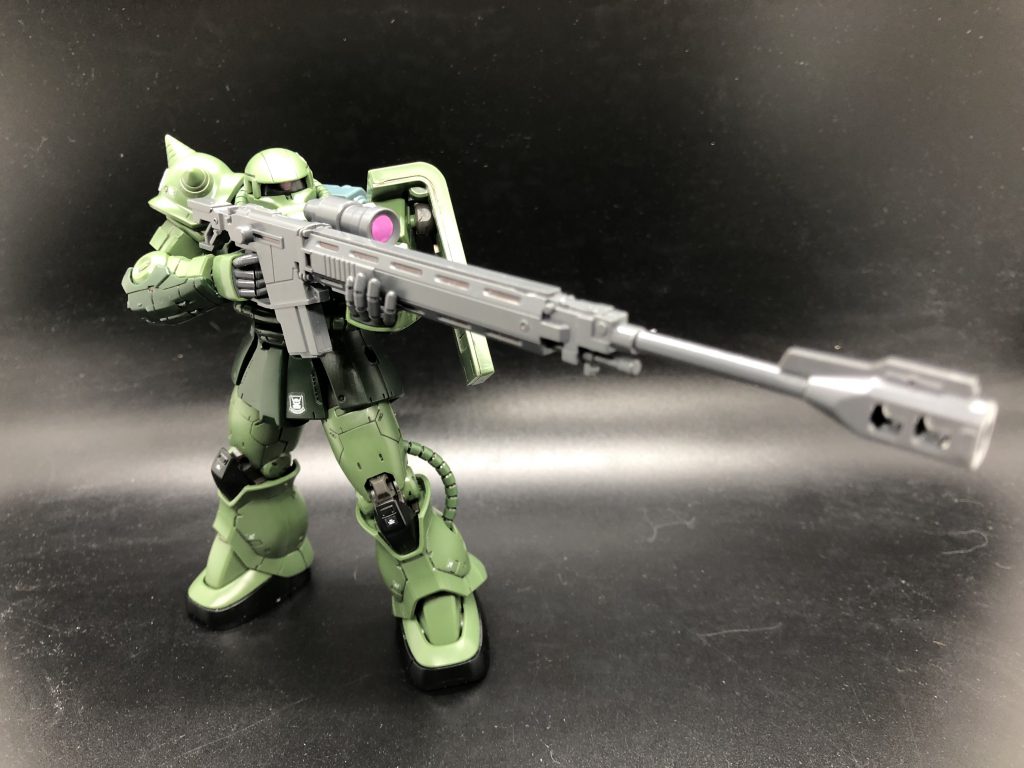
The Zaku endures deep into the UC timeline, despite being cannon fodder even before the end of the One Year War (it’s only seen as a legitimate threat in any form during the final episode of 0080: War in the Pocket, and for about the first 20 episodes of the original MSG). It sticks around because the design is just so good. Freed from the constraints of being a humanoid toy that appealed to kids – no one expected anyone to buy the antagonist designs, but they messed up and made it slap super hard, so nerds bought a ton of them – the design of the Zaku gets to fly its freak flag just a little bit. It’s nothing compared to what Zeta would get away with later, but we can all feel better watching them get smashed up because they’re cyclopes weirdos with tubes all over instead of something that reads as human. It’s why stormtroopers have helmets.
The most common Zakus we see in the shows are the F type – the mass-production mainstay model – and the S type – which is Char’s, and is only visually different in that it is red and has an antenna. The C-6/R6 is based off of the early-war C type, which was the slower one, because the entire thing was lined with lead, because it was the nuclear-capable warcrimes version. The C-6 is, according to the instructions on the kit here, an upgraded C-type, with a chaingun in the chest (hell yeah), and the R6 upgrade package adds another gun (double hell yeah) on the arm, which makes for the C-6/R6. It is, hilariously, unrelated to the R1 and R2 types, which are late war high-mobility versions that would trounce this thing. The MS06-R2 High Mobility Type in particular hits properly Gundam levels of performance, whereas the C-6/R6 not only doesn’t equip beam weapons, it doesn’t even have the standard Zaku 120mm machine gun, because neither hadn’t been invented yet.
So this is a variant that briefly appears in a canon prequel series, but it is more or less indistinguishable from the incredibly iconic mech from the flagship series. There’s no way to talk about the C-6/R6 then, without also talking about the versions that appear in, almost without exception, all UC Gundam. MSG, Zeta, 0080, 0083, 08th MS Team, Thunderbolt, the list goes on. The Zaku, or some type of it, is in all of them. A sniper version of the damn thing shows up in Unicorn, set almost 20 years later. In its own way, this is the TIE Fighter of Gundam: it appears, in some guise or another, virtually everywhere, and is a hallmark of the setting.
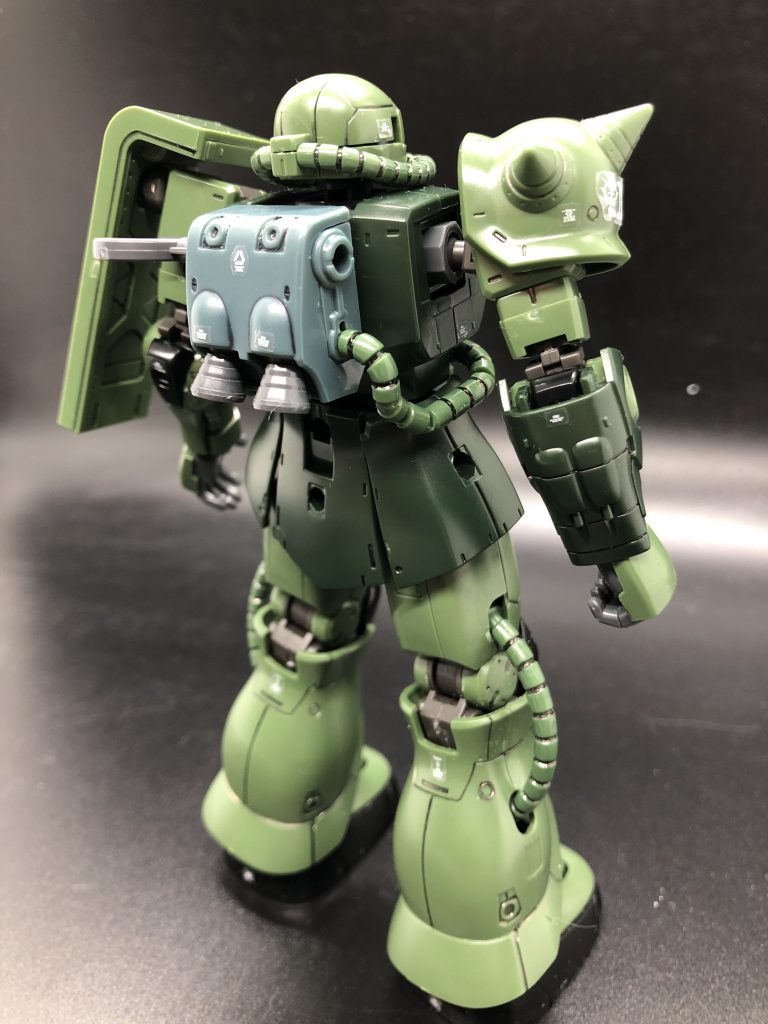
In that context, treating this as a representative of the Zaku II in general and not as something that amounts to a cameo appearance from Origin, the goofy jobber in its green-on-green camo scheme is absolutely one of the most recognizable and influential designs in mecha history. Not just Gundam, anything with giant battle robots in it. It got put on a postage stamp in Japan. The bones of the Zaku carry on in its direct descendants – the Hi-Zack, the Geara Doga, most of the weird Titans/Neo-Zeon stuff in Zeta and Double Zeta. The Big Red Eyeball Over Tubes look started here and made its way into basically every bad guy robot in the last 40 years. It dictated the look and feel of the alternate-universe grunts: the GINN from Seed is a pretty straight update of the Zaku II, and there’s a reason that the Graze, Leo, and Tieren are all presented as faceless mooks with green paintjobs and model numbers ending in 06. Even outside of Gundam, we have Cherno Alpha from Pacific Rim, which Guillermo del Toro acknowledged drew from the same well.
So while there might not be a particular attachment to the (inhales deeply) MS-06C-6/R6 Zaku II Type C-6/R6, there sure as hell is for the Zaku. The wider concept, the general type of thing this is, if not the particular example in question – is simple, practical, militaristic and brutal, and basically what you might expect a mass-produced war machine to look like. I love it so very much.
The model
This is mostly an out-of-box build, including all of the sticker-decals. I did panel line it with a Gundam Marker, but didn’t apply a matte topcoat.
This model kit came out in 2019, but is based off a kit that was new from 2017, the Zaku II C5. As such, it’s a good example of late-era Bandai technology and materials. It still uses polycaps for the joints, but the build is fairly straightforward with no particular gotchas. The plastic is sturdy and cuts easily, though some colors – the dark green and the black in particular – do show marks pretty easily if you aren’t careful when snipping. It’s worth the extra hassle, because the slightly darker color scheme looks so much better. Surface detailing is lovely. Not up to the level of the RG Zaku, and the color separation isn’t even close, but considering the price gap and how utterly annoying the tiny little bits on that kit were, “close enough” might make this better overall, even if it’s slightly less intricate.

The accessories are great, and are in fact why I decided to buy this thing in the first place. Specifically, the huge anti-ship rifle, which is one of the coolest Gundam weapons. It’s longer than the mobile suit is tall, with nice sharp detailing and some realistic features that someone who knows more about guns would probably appreciate. You also get a bazooka (with two extra magazines, so three total), a belt-fed machine gun with a very nice flexible ammo feed (a common problem with these is for the plastic to not be quite flexible enough, and tend to shove the arm around when it’s connected – blessedly not an issue here), a heat hawk in both collapsed and extended modes (the collapsed version has a peg for storing on the side skirt, the extended one does not), and some extra hands. The hands are nice for what they are – they hold all the weapons securely, and the open hand is fun for two-handed rifle poses – but not perfect. For a kit with this many huge guns, it’s a serious letdown that there’s only one gun-holding hand. Gundaming around with an off-hand rocket launcher while blasting fools with a sniper rifle would have been insanely cool. The rifle is too big for the Zaku to one-hand it anyway, but I have a Master Grade Zaku II that can rock a machine gun and a bazooka, and it would have been nice to have the option of copying that loadout. Alas.
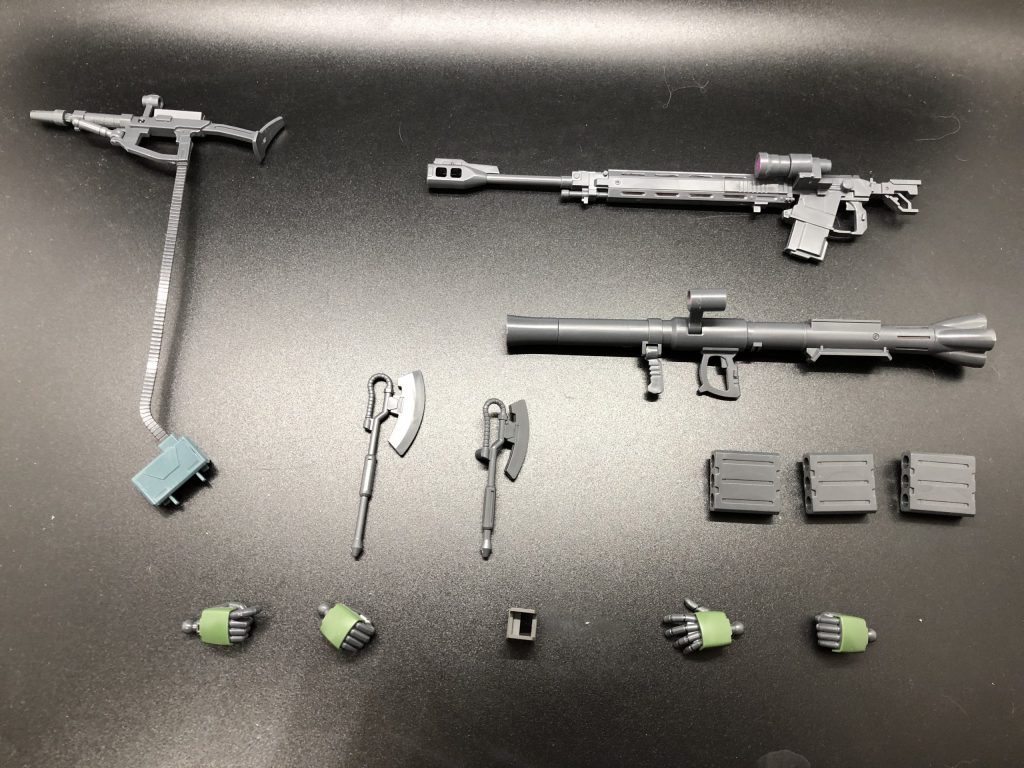
It can, barely, for some values of success, carry all of its accessories at once, though it looks goofy as hell doing so and stuff falls off all the time:
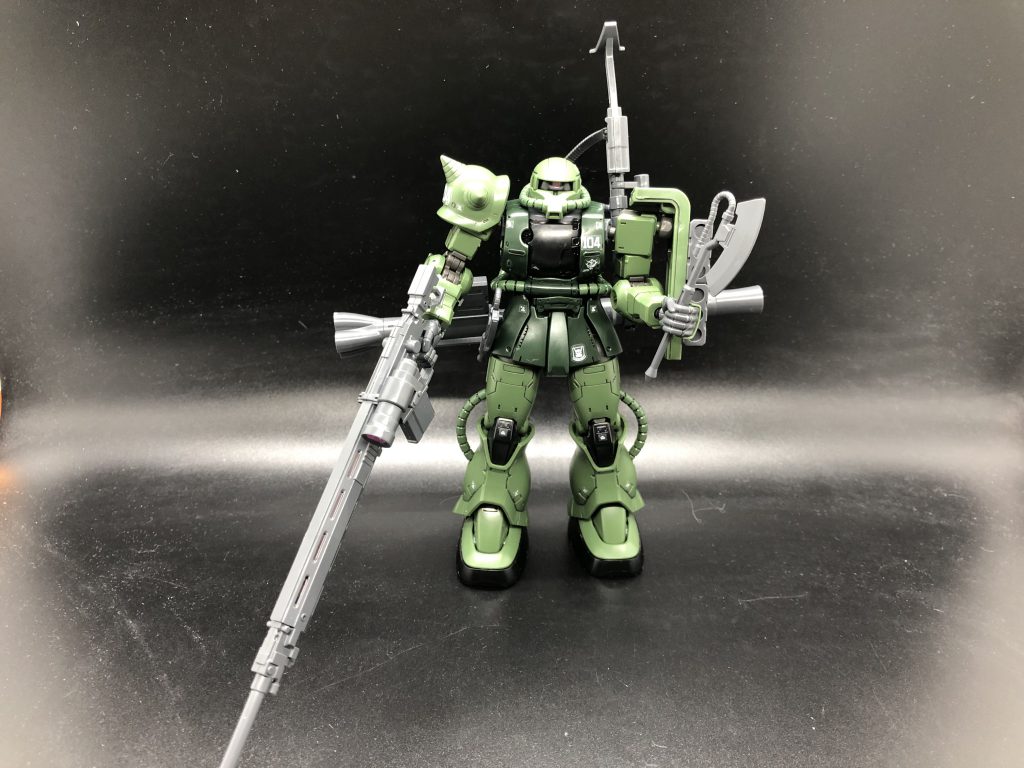
Since this is a re-release/upgrade to an existing kit, we get everyone’s favorite thing: spare parts. The R6 parts are optional and called out in the instructions, so if you’d rather build just the regular C-6 you can. If, for some reason, you bought this before realizing that you really like the C-5 more, you can build that one too. You can probably build a normal C-type, even. Again, not sure why you might do that, but you can.
There’s also a variant shoulder pad missing a couple of spikes, a new dome with a slot for the commander’s antenna, and two choices of backpacks. Both backpacks work with the ammo feed on the machine gun, but one of them has a couple of extra sockets on the side for storing the bazooka, so I recommend using that one. There’s a lot of room for variation, but rest assured that any fit you put on here, it will go stupid hard.

The stickers are fine, for the most part, mostly consisting of logos and warning labels. One on the chest in particular has issues with having to cover a pronounced bump, and the one on the shoulder pad just won’t lay flat (if you’ve ever tried to apply a chapter badge to a Space Marine pauldron, you know this pain). None of them are color-correcting, just decorative, and we get a set of unit numbers, allowing for units 101 through 105. I went with 104 for no particular reason, but if you care about heraldry these do indicate certain characters from the show and in some cases match up with the variant parts. There are no metallic-style stickers, not even for the monoeye or the gun sights, which would have been nice to see, but this is still a high grade, even if it’s a very good one. It’s also clever, the way the stickers cover some of the more obvious seam lines or scarring from sprue connection points. I’d rather they just engineer around those, but covering them in a warning sticker is an easy enough workaround.
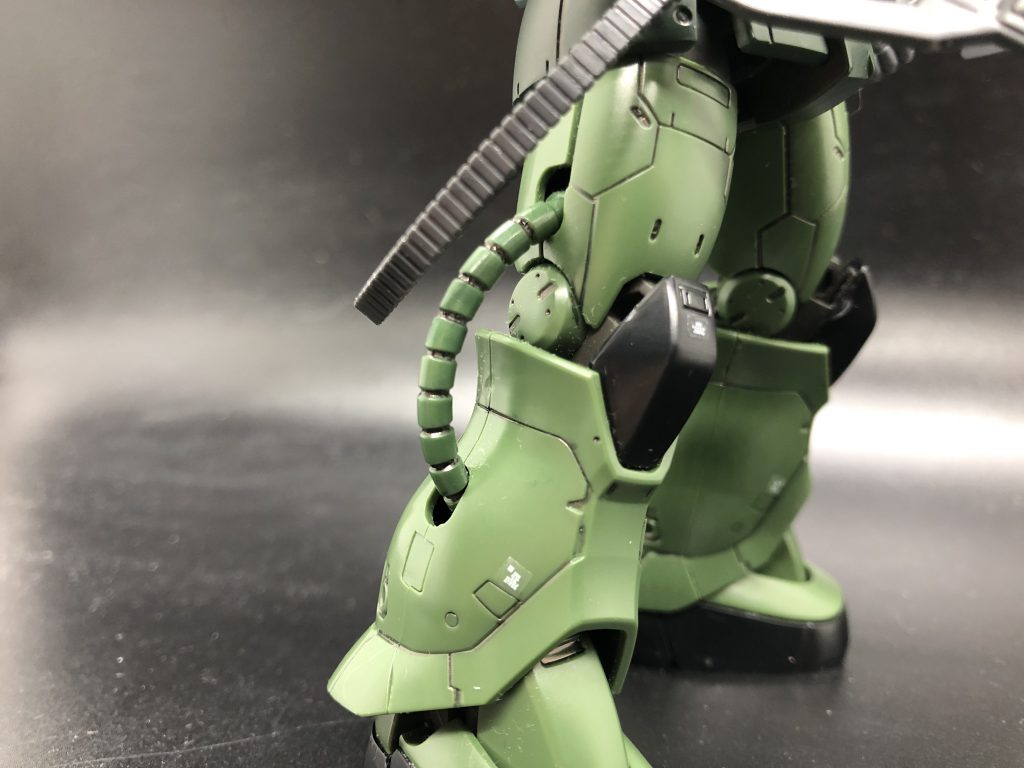
Poseability is good. A lot of Zakus, owing to the basic design, don’t include any sort of ab crunch or waist rotation, so even though we don’t get a lot here, we get something, and that’s nice. The elbows bend almost a full 180, and the knees are genuinely about as good as you could get without significantly re-designing the thing. If there’s a weak spot, it’s the side-to-side movement on the ankles, but even then, it can pull off whatever it needs to pull off. The shoulders can swing forward, allowing for a crossed-arms pose or supporting the weapons with an extra hand, another great but somewhat uncommon feature. All of this works exceptionally well, because the construction is extremely solid. It holds a pose after you put it in one, and has none of the falling apart or falling over problems that we’ll see in the RG Zeta. There is something to be said for simplicity of design, which is true for both the Zaku in canon and the physical kit here.
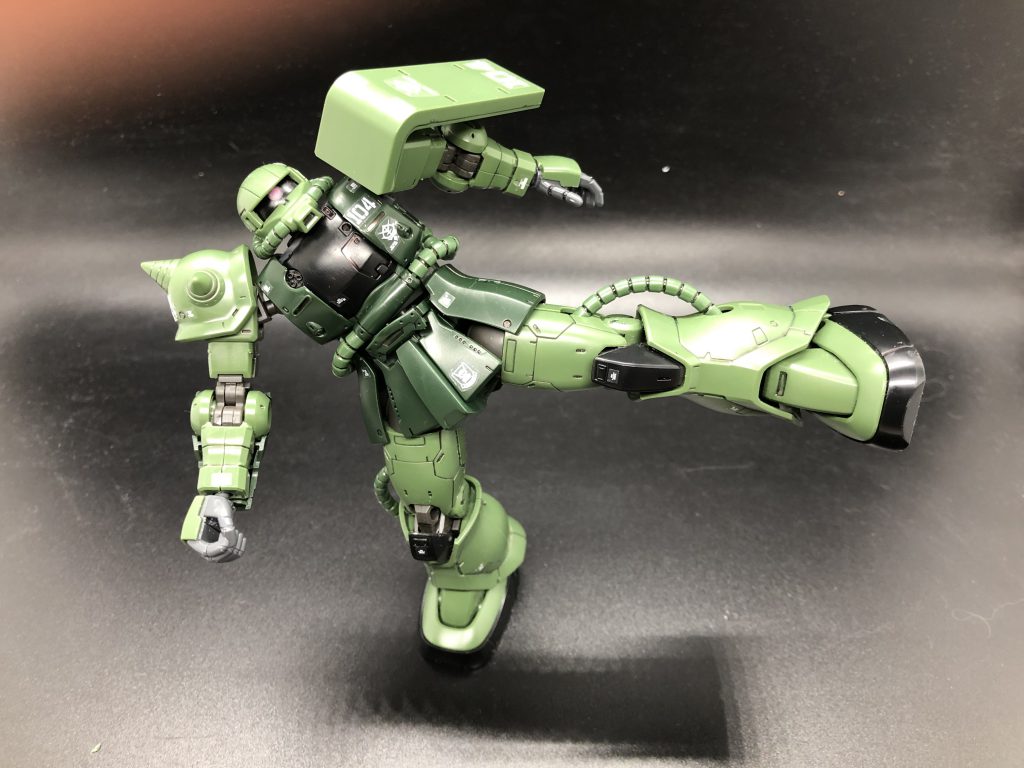
Should you buy it?
Probably, yeah. If you want a 1/144 Zaku in green, and aren’t hung up on having any particular type, it’s hard to top this one. The Origin line in general is great. There’s no mechanical frame, but surface detailing (if not color separation) is approaching RG quality, and the accessories are bar-none the best of any Zaku in any grade. It’s not anime accurate to MSG, but it is fairly accurate to The Origin, which is good.
If you want the red one, there’s a Char version available as well, that comes with basically the same stuff, just with a few more stickers worth of pinstriping and an extra machine gun (the classic Zaku weapon, with the drum magazine on top). The Char version does use a more red and less pink color scheme, which I prefer to the original salmon look.
All in all, this is a great little robot, especially for the price. Given that the RG is showing its age a bit (the hands suck and it’s a pain in the ass to build), this or one of the other Origin kits might be the Zaku II to buy.
